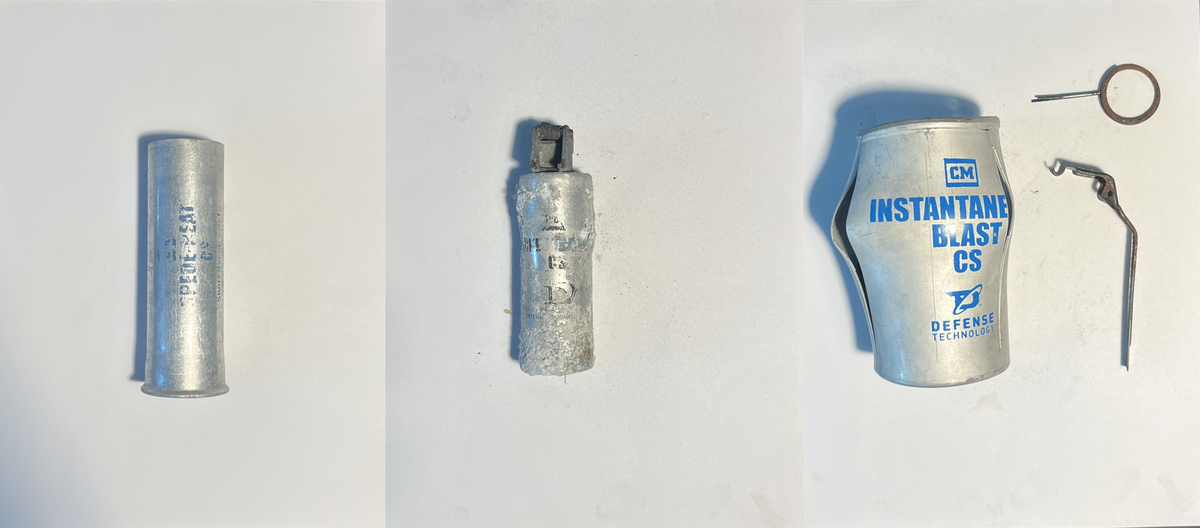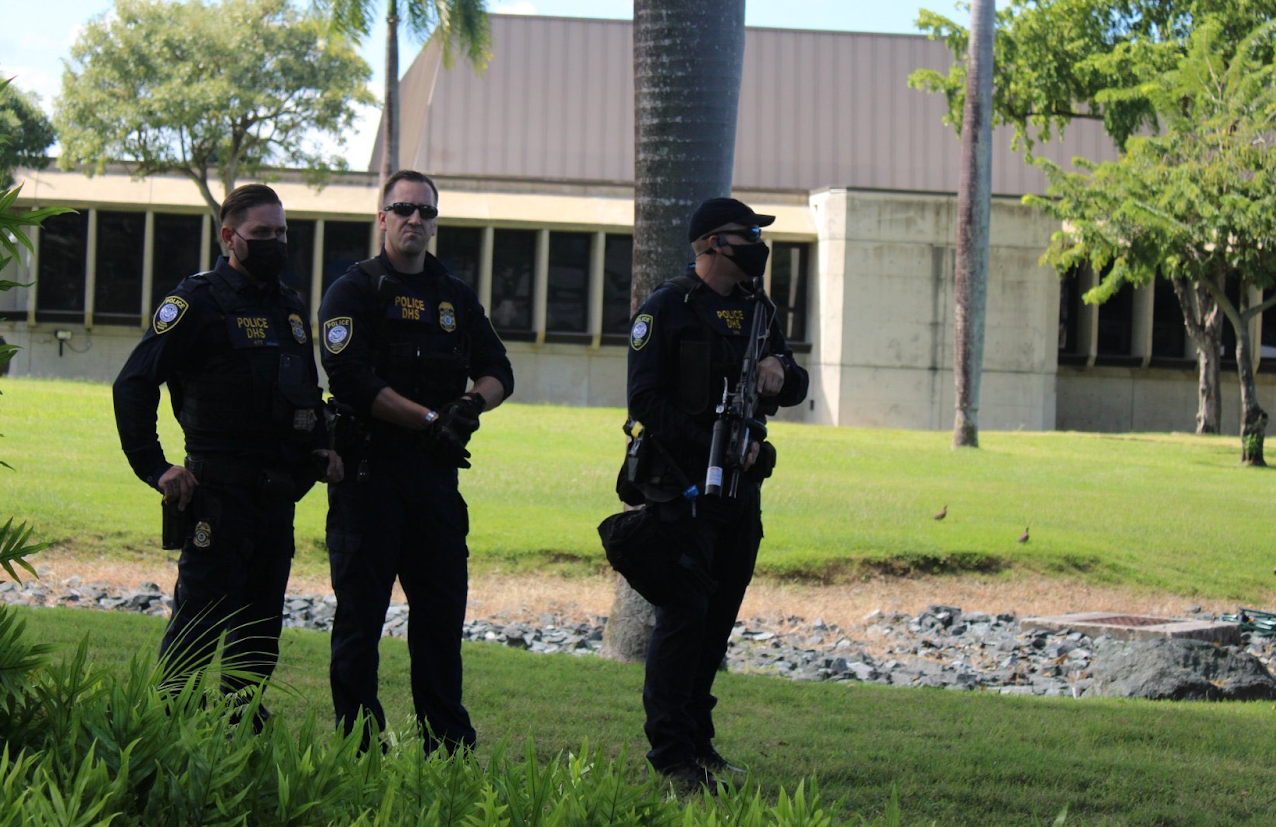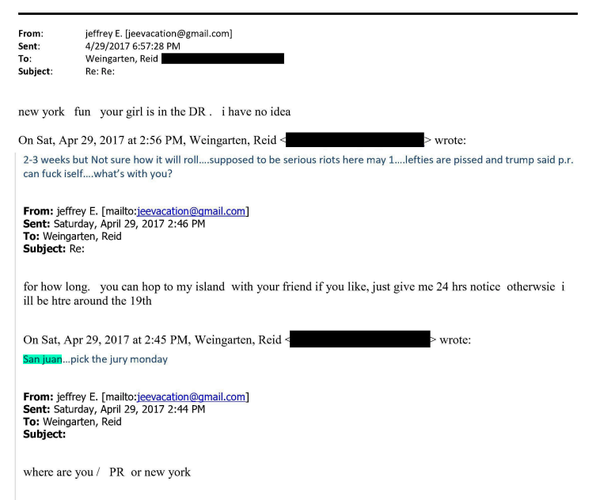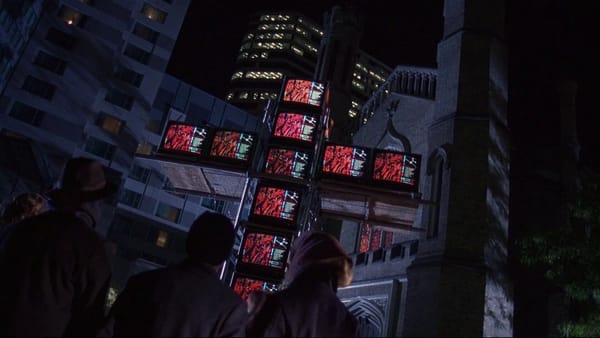A Catalogue of the Riot Munitions Used in Puerto Rico
Based off research and personal experience, I've created a list of the riot munitions used by cops and federal agents in Puerto Rico against protesters.

Editor's Note: I translated this article into Spanish so that Puerto Ricans can easily reference it if they plan to attend a protest.

Has this ever happened to you and you wondered what exactly was thrown at you?
Well, look no further, because I’m here to explain.
While cleaning up my closet, I stumbled on a weathertight box filled with riot munitions that I collected during a weekend of protests in Old San Juan a couple of years ago. One of them is looking pretty rough. So, I will be throwing it out because it’s probably not good for anybody’s health to have a thing like this near them even if it’s in a sealed box. However, before I dispose of it properly, I want to take this opportunity to detail the different types of riot munitions that Puerto Rico’s police use against protesters and journalists.
There's little-to-zero coverage of police equipment in Puerto Rico that doesn't also come with praising them for spending millions more on guns or surveillance equipment, which is why I've made this guide. It's by no means meant to be completely comprehensive, just an introduction for people to be better prepared when they go to a protest. I plan on updating it as I get more information or I see new things used.
Before I start, I want to talk a little about why I’ll be referring to them as “riot munitions” and not “less-lethal munitions.” Some of these weapons — especially the kinetic impact projectiles — can easily be lethal depending on where you’re hit and how close you are to the person shooting you. Dozens of people have been killed and thousands have been maimed by rubber bullets, according to a 2023 Amnesty International report. Meanwhile, chemical irritants have been linked to lung damage and negative effects on reproductive health, among other health problems. Getting shot directly with a tear gas canister can also be deadly.
Most of the riot munitions used against me in Puerto Rico were deployed by state police and manufactured by Defense Technology in 2019. Some of these munitions run extremely hot while they spew gas so do not pick them up unless you’re sure they’ve cooled down.
For a variety of reasons, it’s far more likely that you’ll be hit by a police baton or pepper spray before smelling even a whiff of tear gas in Puerto Rico. Getting hit by a baton hurts like a motherfucker and can easily be deadly if you’re hit in the wrong spot. Pepper spray, meanwhile, also hurts like hell and is much worse than tear gas in my experience because it will stay in your eyes and drip to other parts of your body. Anecdotally, if you’re covered in sweat like I am during every single protest I’ve ever been at, it will spread everywhere.
Pepper Spray & CS Spray
Before I start talking about pepper spray, I really quickly want to clarify something. In Puerto Rico, the media tends to say “gas pimienta” (literal translation: “pepper gas”) or "pepper spray" to describe all types of spray or aerosol-based chemical irritants, as well as tear gas. While all of these are lachrymatory agents, the language is imprecise. So, I will use “pepper spray” ("espray de pimienta," in Spanish) for all forms of aerosol-based chemical irritants that use Oleoresin capsicum (OC), which is the thing that makes peppers spicy. Meanwhile, I will use “CS spray” for all aerosol-based chemical irritants that use o-Chlorobenzylidene Malononitrile (CS), which is also what most tear gas used in the US is made out of. Meanwhile, I’m going to be referring to tear gas and all of its distinct forms as “OC gas” or “CS gas" depending on what I'm talking about.
There is also “pepper spray” and “pepper gel.” The former sprays its contents in a cone-like form while the latter has a thicker consistency and you have to be more accurate with it because it shoots in a straight line. Pepper gel sticks to its target more than pepper spray and is harder to wipe off (ask me how I know).
Since these are all lachrymatory agents, they will make you cry uncontrollably and make it feel like your eyes are going to burn off. The best thing to do when you’re hit with any of these is to wash your eyes thoroughly with clean potable water or saline solution[[1]]. Anecdotally, saline solution seems to work better. But you will more than likely not have it on hand when you need it. Do not use anything else to flush out your eyes. Sudecon decontamination wipes also work wonders to deactivate the chemicals in pepper spray or CS spray. Make sure you’re doing this when you’re safely away from anything else that can harm you (i.e. not right in front of a riot line).
I’m unsure of which specific brand of pepper spray and CS spray Puerto Rico’s police use. However, it seems like they tend to use Defense Technology’s various aerosol-based products based on pictures and videos I’ve seen. Regular cops, the ones you’re most likely to encounter in your day-to-day, use small pepper spray canisters that fit onto their belts. There are several versions of these and they can carry different compositions of OC. Regular cops are not allowed to use any other type of chemical irritant, according to a police directive. While the most common type of aerosol-based chemical irritant that people will run into is the small pocketable version, there are also larger canisters that have a pistol-like grip that are commonly used at protests.
The Special Tactics Unit (SWAT) are allowed to use CS spray. Other chemical irritants, like chloroacetophenone (CN) are not allowed to be used in Puerto Rico, according to the same police directive.
Tear Gas (CS)
Tear gas tends to be the thing that most people associate with a protest "turning violent" because photojournalists (like me) love to photograph stormtroopers coming out of the huge clouds it makes. It's a big Jin-Roh: The Wolf Brigade vibe.
Here's an example of what I'm talking about:
The purpose of tear gas – like every other riot munition – is not just to disperse people or to hurt them. It’s meant to intimidate people as well, to make them afraid to come out to protest again. That’s why it’s important for people to know what exactly they’re up against if they find themselves in a cloud of tear gas.
"Tear gas" is a catch-all term for a bunch of chemical irritants that include OC gas (pepper spray), CN gas (which is not used much anymore, and CS gas (the most commonly used one across the United States in my experience), among others. I'm primarily going to be talking about CS gas in this section because that's the only thing I’ve personally witnessed used in Puerto Rico.
CS gas is another lachrymatory agent that can cause you to cry uncontrollably, make it hard to breathe, and make your skin itch. It can also cause you to retch and vomit. The one good thing about tear gas is that — if you manage to leave the area where it’s been deployed — many of these effects will be significantly alleviated. If you’ve been hit with tear gas, you need to flush your eyes with water or saline solution, just like with pepper spray. Do not used any other dumb concoction you saw on a random Twitter post. Sudecon wipes are great for this too. Also, if you have a respirator, make damn sure you have it on before you’re in a cloud of tear gas or you will create a mini gas chamber inside your mask, which has happened to me.
The canister above on the left is a “Spede-Heat 37mm Short-Range Round, CS” meant to be deployed from a device that looks like a grenade launcher. These specific canisters are supposed to be shot upwards at an angle so that it falls into the middle of a densely-packed crowd and makes them disperse. According to the manufacturer, it can also be skip-fired, which just means bouncing it off the ground. It is NOT meant to be fired directly at people because it can easily be deadly, Defense Technology says.
While I only have the outer shell, the way that it works is that there’s a smaller aluminum projectile inside of it that disperses CS gas when it’s deployed. The gas comes out of holes on either end of the projectile. There’s other types of Spede-Heat canisters that carry OC, smoke, and other type of crowd control gases.
Meanwhile, the grenade in the middle is a “Pocket Tactical Grenade, CS” that you can throw by hand or attach to a special launching cup to shoot it from a riot shotgun. I can’t tell you why it looks calcined like that, but I’m sure it can’t be healthy and I’m going to dispose of it properly as soon as I’m done with the video I’m recording explaining some of these munitions.
Unlike the Spede-Heat, the pocket grenade only ejects CS gas from a small hole in the bottom. It can be deadly if launched directly at someone while using the launching cup, and it will burn the shit out of you if you grab it before it’s completely cooled.
There’s a fairly simple way to negate the effects of a tear gas grenade. Here's an example of how much CS gas one pocket grenade can deploy:
Last but not least, there’s the “Instantaneous Blast CS Grenade.” It has a bunch of CS in powder form inside of it that explodes into the air immediately when it’s deployed through the six machined grooves along the grenade, which is what gives it that crushed by a hydraulic press look. Because it’s a powder and not a gas, it can be more easily carried by the wind and spread over a large group of people. The benefit of these grenades is in the name, it’s instantaneous and you don’t have to wait for all the gas to come out.
Like other CS grenades, it’s thrown by hand. However, the specific one that I have seemingly malfunctioned, probably because it was raining down pretty hard when it was thrown (another example of how lots of water can help against CS). The internal detonator seemingly failed to detonate properly and all the powder dispersed onto Old San Juan’s wet cobblestone streets.
Here's what that looks like:
Smoke Grenades
There’s not really a lot to say about “Saf-Smoke White Grenades” other than they’re smoke grenades that disperse a thick cloud of white smoke for 20-40 seconds. Cops used them to disorient a group or hide their positions. Defense Technology advertises it’s Saf-Smoke formulation as “considered to be less toxic” than Hexachloroethane (HC) smoke, which is used in smoke grenades used by the military. However, Saf-Smoke is still seemingly carcinogenic.
The way to deal with them is the same as with other gas grenades.
Batons
Although I can’t confirm it, I’m reasonably sure that the baton they use is Defense Technology’s Grenade Grip Straight Black Polycarbonate Baton. These batons they use during protests are different from the expanding batons they use during their day to day. Police grasp them at both ends then push very hard against someone's center mass to make them fall over or push them away. Once you’re on the ground, it’s much easier for two or three cops to get on top of you and arrest you.
Rubber Balls
A note before continuing, “rubber balls," sometimes also called "rubber pellets," are different from “rubber bullets.” While it’s not clear what Defense Technology’s rubber balls are made of, most rubber ball projectiles used around the world are usually a metal ball with a thin rubber coating or made out of a mixture of substances that produce a ball much harder than regular rubber. Meanwhile, rubber bullets are similar but much thicker, hurt much more, and can more easily be deadly.
I’ve personally only seen Puerto Rico’s police use rubber balls. However, the two terms are used interchangeably.
While they can be shot individually, rubber balls are more commonly packed into shells like the ones above then shot at protesters. They’re part of a huge category of riot munitions called “kinetic impact projectiles," which include rubber bullets, foam-tipped rounds, and wooden baton rounds.
The large black shell casing above on the left is a “Stinger 37 mm 32-Caliber Rubber Balls Round (5.5″ Casing).” It can hold “approximately 175 32-caliber rubber balls," according to Defense Technology's website. They're meant to be deployed in low trajectories or skip fired. According to Defense Technology, they can be direct fired but the trajectory must be kept low to avoid the breast line. If they’re skip-fired, they will bounce indiscriminately at anyone in the general direction in which they’re deployed.
There are models that use an 8” casing and can use 60-caliber rubber balls. There are also 40mm models. They’re fired from the same device described above used for the Spede-Heat.
Meanwhile, the shotgun shells on the right are “12-gauge Stinger 32 Caliber Rubber Ball Rounds” and hold about 18 32-caliber rubber balls, according to Defense Technology. Their maximum effective range is about 40 feet and have a velocity of 900 fps, according to the manufacturer. They’re shot from what people call a “riot gun,” which is usually just a regular shotgun wrapped in a bright colour so the cop grabbing it knows it doesn't fire live ammunition. Most weapons used against crowds will be coloured this way.
According to Defense Technology, the 12-gauge round is meant to be "direct or skip-fired at the discretion of the operator, but it is necessary to keep the trajectory low so the projectile spread will not engage the subject above the breast line." However, I've had a riot shotgun pointed directly at my chest.
Over 440 people suffered eye injuries in Chile during the 2019-2020 protests, in part because security forces were aiming indiscriminately at their heads. A rubber ball can pretty easily explode your eyeball, which is why it’s important to wear shatter-resistant goggles. To be clear, this does not mean swim goggles you bought at Walmart. They need to be shatter-resistant.
The night when these were deployed in Old San Juan, at least two people were seriously wounded because they were shot with rubber balls. When you’re shot with rubber balls or other rubber projectiles, they can become encrusted in your skin and require surgery to be taken out.
Several others were injured but did not require emergency medical attention. Here’s an example of what a wound from a rubber ball looks like:
FN 303 Launcher

The one riot munition that I’ve seen used by federal cops (Department of Homeland Security) is the “FN 303 Launcher.” It looks a lot like a paintball gun, but it has better accuracy, according to the manufacturer, FN Herstal. Getting hit by one also hurts more than getting shot with a paintball and can break the skin. The ammunition they use is made up of two sides. The side facing towards whatever they want to shoot, is made up of granulated bismuth meant to fragment when it hits someone and it’s supposed to prevent penetration damage. Meanwhile, the second part has one of several liquids that can range from paint to pepper spray.
When DHS deployed it against student protesters a couple of years ago, they used pepper spray ammunition and fired a couple before the agent's superior told him to stop. Like other things on this list, projectiles from the FN 303 can be deadly.
TASER
While I've never personally seen it used at a protest, Puerto Rico police have used TASERs against protests in the past, in violation of the guidelines established by the 2013 consent decree for police reform.
From the photos and videos I've seen, they tend to use TASER 10s, manufactured by Axon (formerly known as TASER International), who also manufacture the body cameras (Axon Body 3 and 4) used by Puerto Rico’s police. The government entered into a contract to buy 10,000 TASERs in 2024.
If you want a thorough look at TASER usage in Puerto Rico, read this story by the Centro de Periodismo Investigativo about the archipelago’s police crisis intervention program and their liberal use of TASERs against people.
If you want to learn how to deal with being hit by a kinetic impact munition, please take a Stop the Bleed class. Not only will that help you deal with any injuries you see at a protest, that knowledge could help you when you least expect it. While Stop the Bleed isn't common in Puerto Rico, there is a Stop the Bleed class online, and there are several local trainings you can take if you put "first aid" and "Puerto Rico" into your internet search bar.
This was by no means meant to be a thorough breakdown of riot munitions and their effects. If you want that, check out this article by Crimethinc and this video from Newsy and Bellingcat. Read this Wired article as well. However, if you've read up to this point, you’re better equipped for any situation you find yourself in. I plan to update this document with new information if I ever run into any new riot munitions or get some more date on them.
[[1]]: Unless you have saline solution or Sudecon, ONLY USE WATER TO CLEAN OUT YOUR EYES. Every time tear gas has been deployed in Puerto Rico over the last decade, I've seen people recommend some concoction or another that includes things like vegetable oil or antacids, which DO NOT BELONG IN YOUR EYES. You might actually make a bad situation worse if you use these things. You do not know what someone is allergic to. Oil will trap the chemical irritant to your skin and make the pain worse. Meanwhile, studies have suggested antacids do not help in any meaningful capacity and can actually cause irritation or damage to your eyes.






